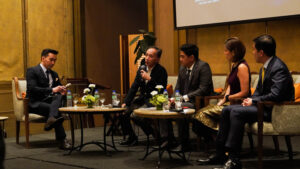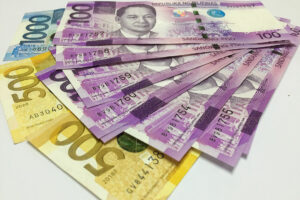Unfolding the trajectory of Philippine stock market

By Mhicole A. Moral, Special Features and Content Writer
While picking up from the significant drops in performance due to various factors such as global trade wars, geopolitical conflict, and a worldwide pandemic, the Philippine Stock Exchange (PSE) closed the year 2023 with a slight loss, ending at 6,450.04 with a year-to-date loss of 1.77%. Investors and analysts, however, are seeing a lot of hope in 2024. The PSE itself anticipates that local equities would recover lost ground in 2024 as a result of monetary policy relaxation and the ongoing revving up of the economy post-pandemic. The local stock barometer, meanwhile, is forecast to move inside the 6,800 to 8,300 zone this year.
More predictions on the future of the Philippine stock market, as well as the opportunities and challenges that lie ahead, were explored in a BusinessWorld Insights forum, themed “Stock Market Outlook 2024,” last Feb. 27 at Dusit Thani Manila.
Ramon S. Monzon, president and CEO of the Philippine Stock Exchange, delivers his keynote address in a recorded video.
In his keynote speech, PSE President and CEO Ramon S. Monzon said that the Philippine stock market is showing signs of revival after a prolonged period of stagnation. He revealed that the market closed positively, reflecting a 6.8% increase for the year.
“For January 2024, foreign investors were net buyers in the amount of P4.49 billion compared to being net sellers in the amount of P53.65 billion for the whole year of 2023. The country’s economic indicators remain strong as GDP grew by 5.6% in 2023,” he said in a recorded video.
Similarly, Michael Gerard D. Enriquez, president of Sun Life Investment Management and Trust Corp. (SLIMTC), also noted the country’s economic backdrop, albeit seeing challenges still under way for the stock market.
Sun Life Investment Management and Trust Corp. President Michael Gerard D. Enriquez
“[For] the overall economy of the Philippines, we’re expecting a 6% growth for this year. So, economic backdrop is very supportive of a good year for the Philippines. [Valuations are] very attractive but remains to be just attractive. It’s not moving higher,” said Mr. Enriquez.
He mentioned that historically, the Philippine stock market has averaged around 15 times, with the potential to surge to over 20 times during bull phases. Mr. Enriquez highlighted the significance of the 8.4% earnings-per-share (EPS) growth, coupled with a 12.8 times price-to-earnings (P/E) multiple.
“We’ve all seen how the market has really close to 7,000 during the last week. So, the next question, will it continue? Will it hold on to this rally? Every year, in fact, we have noted strong start of the year, only to realize that it weighs down towards the latter part of the year,” he emphasized.
Mr. Enriquez also said that despite the performance of local companies in the Philippines, with continuous growth emerging from the pandemic, there seems to be a disconnect between corporate success and financial market performance.
Despite resilient corporate earnings and attractive valuations, the Philippine Stock Exchange Index (PSEi) has lingered between 6,000 and 6,800. Mr. Enriquez attributed this underappreciation to macroeconomic headwinds that have affected investor sentiment, hindering a more robust influx of capital.
“Over the last two years, we have been experiencing such a high interest rate in our economy. And for an investor, if your bank offers you 5%-6% time deposit rates, you’d probably go to your bank and not invest in these assets or revenues. Plus, you’d probably hear of a lot of the geopolitical risks happening. And because of those, a lot of the investors are just staying put on fixing our business,” he said. “However, we have noted a lot of developments over the last three months to support our case. We’ve been experiencing macro headwinds,” he said.
Influential risks
COL Financial First Vice-President For Corporate Strategy and Chief Investor Relations Officer April Lynn C. Lee-Tan
April Lee-Tan, chief equity strategist of COL Financial Group, Inc., said that the global economic landscape in 2023 witnessed a surge in inflation and interest rates, not sparing the Philippines. The combination of these two factors had a negative impact on both consumer spending and investment.
She considers the state of the US economy and stock market as the most significant risk.
“For me, the biggest risk is the US economy and the stock market because, in my opinion, I feel that they are facing a heightened risk of a recession. If that happens, there’s potentially a bear market,” she said. “Historically, the Philippine market has never escaped from a contagion. We’ve always suffered from a contagion. So, if that happens, could this time be different?”
Ms. April Lee-Tan also points out that the government’s budget for 2024 has seen a notable increase of approximately 9%, with an 8% rise in productive uses. However, she raises concerns about the optimistic assumptions made during the budgeting process.
“The GDP growth forecast to achieve the budget was around 6.5%-7.5%, and the consensus forecast for GDP growth is around 5.8%. So, if your GDP growth is lower than what you’re projecting, of course, you would get less revenue,” she said. “Unfortunately, my worry is either the government fulfills the 8%-9% increase in the budget at the expense of a much larger deficit, or it can just do what it did last year — underperformed.”
While there are positive notes, such as higher-than-expected job numbers and a 3.3% fourth-quarter GDP growth, Ms. Lee-Tan emphasizes the need for cautious optimism.
“It’s hard to say with conviction that things would not suffer from a hard landing when you have other information, such as the decline in the number of hours worked, which seems to imply that a lot of employers are hiring temps instead of full-time workers,” she shared. “And then the GDP growth, which was really very strong, was driven by the government. But if you look at both of them, they’re not very healthy.”
Another key factor influencing the global economic landscape is the role of the United States Federal Reserve. Ms. Lee-Tan pointed out the historical challenge faced by the Fed in orchestrating a soft landing after raising interest rates. The correlation between rate hikes and economic recessions is evident in the chart presented, raising concerns about the potential impact on the Philippine stock market.
“The Fed has a difficult task of staging a soft landing. [You] will notice that every time the Fed raises rates or almost 100% of the time, the economy suffers from a recession. There have been times where it never happened, say in the 1990s or in the 1980s. But, usually it doesn’t happen if there is no yield curve. Unfortunately, the yield curve in the US has been in birth as of July of 2020,” said Ms. Lee-Tan.
Comparing the Philippine stock market to the US market, Ms. Lee-Tan noted that while the Philippines is relatively inexpensive, the US market is considered expensive, trading at around 20 times earnings. This suggests that the Philippines may not have fully priced in the global economic challenges, presenting both risks and opportunities for investors. However, historical trends indicate that during crises, investors tend to flock to the US dollar as a safe haven, potentially limiting the positive impact on the Philippine stock market.
Predictions
Philstocks Financial, Inc. Research and Client Engagement Officer Mikhail Philippe Q. Plopenio
Mikhail Philippe Q. Plopenio, research and client engagement officer of Philstocks Financial, Inc., said that understanding the trajectory of the stock market in the past year is crucial in projecting what to expect in 2024.
He noted that the Philippine stock market faced significant challenges in the past year, as it experienced a downward trend. Although attempts were made to rally the market, they were unsuccessful, and as a result, the market moved sideways in the middle of 2023, followed by a further decline in the second half. In fact, the market’s struggle was evident in the tepid value turnover, which was down by 18.09%, indicating that investors preferred to stay on the sidelines. Net foreign outflows amounted to 49.08 billion, highlighting the continuous exodus of foreign funds.
Despite the challenges, he mentioned that the market’s P/E ratio reached attractive levels in 2023.
“If you are to look at the market’s P-Racial, it’s at attractive levels,” he explained. “In fact, the P-Racial of the PSEi as of [the] end of 2023 was 13.2 times [higher]. Comparing it to the historical performance, it was the lowest since 2009, 12.6 times. And if we are to compare it to our regional peers, it’s also undervalued as the industry; the regional average was 17.6 times. So, this goes to show that the market is already at bargain levels.”
According to Mr. Plopenio, this apparent undervaluation sparks questions about whether being at bargain levels alone is sufficient for investors.
He anticipates the Philippine Peso to average between 54.80 to 55.80 against the US dollar, driven by a surplus in the balance of payments. This surplus is expected to result from increased service exports, a surge in Overseas Filipino Workers’ remittances, and a rebound in net foreign direct investments.
In terms of inflation, a decline is projected for 2024, attributed to base effects and the impact of the central bank’s tightening measures in previous years.
“For the prices, we expect inflation to decline this 2024 and settle within the 3.8% to 4.2% average. As we all know, this is due to base effects as inflation has peaked in the recent year. Also, the impact of the tightening of the BSP in the previous years is expected to take effect this year, which would somehow affect demand-side inflation,” he added.
He also predicted that there are expectations that the Bangko Sentral ng Pilipinas (BSP) will cut interest rates twice by 2.25 basis points in the second half of the year. This move would bring down policy rates to 6% by the end of 2024.
“As interest rates are expected to be cut this year, we expect the GDP to grow by 5.4% to 5.8% this year. This is on the assumption that consumption will remain robust for this year, as we expect a decline in inflation and labor market remains to be tight this year,” he explained.
In the context of the anticipated positive macroeconomic environment, the PSEi is expected to achieve earnings-per-share (EPS) growth of 5% to 15%. Mr. Plopenio suggests that if these projections are met, the PSEi could end the year within the range of 69.98 to 76.65. This translates to a potential upside of 8.51% to 18.84% based on fundamentals.
While the overall outlook is positive, Mr. Plopenio highlights several narratives that could impact market sentiment. These include the Fed’s policy decisions, China’s economic recovery, tensions in the Red Sea, the US presidential elections, and the Israel-Hamas conflict.
Infrastructure push
SLIMTC’s Mr. Enriquez made a compelling case for a shift in the status quo. He argued that despite the prevailing challenges, the current market landscape presents an opportunity for change. He mentioned that one of the underlying themes that sets the tone for the Philippines in 2024 is the government’s renewed emphasis on infrastructure development.
“I think it’s really helping a lot on how the government has been promoting the Philippines and bringing forth a lot of the major infrastructure projects,” he added. “Recently, [we’ve] been seeing a lot of news about the completion of the subway. Again, it’s good headline for the Philippines, and I believe this is one key aspect that’s missing that can tie up the entire theme of why invest in the Philippines and why not another country in Asia.”
BDO Capital President Eduardo V. Francisco
Similarly, Eduardo V. Francisco, president of BDO Capital, noted that one of the primary indicators of the Philippine government’s commitment to economic development is its approach to infrastructure projects. Mr. Francisco highlighted the significance of the recent infrastructure developments. Despite delays and concerns regarding project viability, the government persisted, demonstrating a seriousness that bodes well for the country’s economic prospects.
Mr. Francisco addressed a common misconception about foreign participation in Public-Private Partnership (PPP) projects. While it might seem that local conglomerates dominate these bids, foreign entities do actively participate.
“The foreigners always want to participate in the PPP projects. It just so happens that when the actual bidding occurs, the [conglomerates] are sometimes, or maybe oftentimes, more bullish. They’re willing to take on more risks. So, it’s not that the foreign [investors] are not bidding,” he added. “They’re bidding, but sometimes their IRR requirements are higher because they have country risk versus if you’re domestic. You don’t factor in the regulatory or the political risk. But that doesn’t mean that the foreign [investors] are not interested. It just means that the foreign [investors] lose out to the locals, but they are participating.”
Cautious moves
Moreover, Mr. Francisco revealed that beyond the visible stock market transactions, there is various activities occurring, particularly in mergers and acquisitions (M&A). However, due to disclosure regulations and strategic considerations, many details are not immediately available to the public. The deliberate choice of using non-listed corporations or subsidiaries by buyers reflects the complexity of market dynamics and the need to navigate disclosure rules. He suggests that there is considerable excitement and caution within the financial sector as various entities explore opportunities and strategic moves.
Meanwhile, Ms. Lee-Tan of COL Financial emphasizes the significant role that interest rates and inflation play in determining the health of the stock market. If interest rates decline and inflation is kept in check, it can create an environment conducive to market growth. The lowered interest rates may prompt investors to seek alternatives to traditional savings, such as exploring the stock market for potentially higher returns.
On the other hand, Mr. Enriquez mentioned that investors are looking past inflation and slowly repositioning themselves in the local equity market. Institutional buyers have been overweighing their allocation into domestic equities.
“You’d probably see a lot of liquidity,” he predicted. “If you look at the results of the banks, it’s telling. Deposits increased by more than 10%. Loan growth was significant in spite of the higher margins, net interest margin. And what more if you see rates start to go down, then probably there would be more appetite for consumers, for companies to really take on loans for expansion. And in spite of the high interest rate environment, the confidence is telling that they are willing to borrow to expand to buy big-ticket items. So, I think that’s something that is really going beyond inflation and high interest rates, more than just a stock market. And it has to translate to asset prices.”
As the stock market experienced a pullback after reaching 6,900, Mr. Plopenio of Philstocks advised investors to stay ahead by diversifying their portfolios. While there are positive prospects for the year, he acknowledged the existing risks, emphasizing the need for a diversified approach to protect investors from market volatility.
“There are bright prospects for this year that we should be looking forward to, however, there’s still risks, so being diversified will protect the investors,” he said.
Similarly, Ms. Lee-Tan suggests a strategy which entails capitalizing on stocks that exhibit strong intrinsic value.
“We’re also recommending a higher-than-normal allocation to cash. But, that’s it. It’s not because we’re super bearish. It’s more like assuming that the US does suffer from recession in a bear market, when the stock market moves down, that is the time to deploy the cash because we may think that cash mask is any way to work almost over an amount of money,” she said.
Moreover, Mr. Enriquez explained that the movement towards more typical interest rate levels has significant implications for investors. Historically low interest rates have fueled stock market growth, but a return to normalcy could introduce new challenges.
“As we see the government really serious in its infrastructure push, I think that is something that can definitely be a tailwind for investors to continue to pour money into the stock market,” he reiterated. “Thereby, hopefully in the next 3-5 years seeing the all-time high of the market at 9,000 or 100 in the next 3-5 years.”
This BusinessWorld Insights forum was presented together with Citicore Energy REIT Corp.; in cooperation with Sun Life Philippines and SM Investments Corp.; and was sponsored by AppleOne, BDO Capital, EastWest Bank Corp., Figaro Coffee Group, Megaworld Corp., and Meralco; with the support of the Philippine Chamber of Commerce and Industry, Philippine Franchise Association, and official media partner The Philippine STAR.




